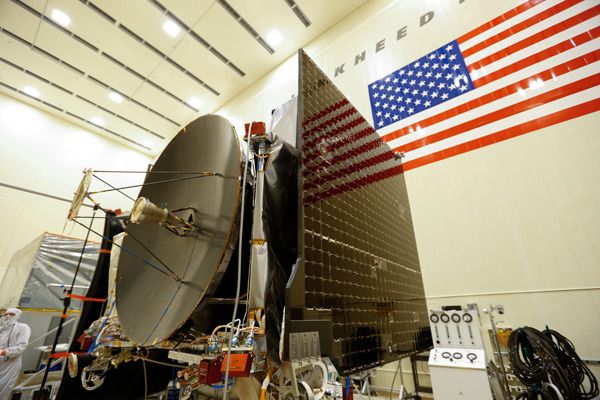
Lockheed Martin Corporation
NASA’s OSIRIS-REx Spacecraft Begins Environmental Testing (Press Release)
NASA’s Origins, Spectral Interpretation, Resource Identification, Security-Regolith Explorer (OSIRIS-REx) mission is undergoing environmental testing at Lockheed Martin Space Systems facilities, near Denver, Colorado. OSIRIS-REx will be the first U.S. mission to return samples from an asteroid to Earth for further study.
"OSIRIS-REx is entering environmental testing on schedule, on budget and with schedule reserves," said Mike Donnelly, OSIRIS-REx project manager at NASA's Goddard Space Flight Center in Greenbelt, Maryland. "This allows us to have flexibility if any concerns arise during final launch preparations."
Over the next five months, the spacecraft will be subjected to a range of rigorous tests that simulate the vacuum, vibration and extreme temperatures it will experience throughout the life of its mission.
“This is an exciting time for the program as we now have a completed spacecraft and the team gets to test drive it, in a sense, before we actually fly it to asteroid Bennu,” said Rich Kuhns, OSIRIS-REx program manager at Lockheed Martin Space Systems. “The environmental test phase is an important time in the mission as it will reveal any issues with the spacecraft and instruments, while here on Earth, before we send it into deep space.”
Specifically, the OSIRIS-REx spacecraft will undergo tests to simulate the harsh environment of space, including acoustical, separation and deployment shock, vibration, and electromagnetic interference. The simulation concludes with a test in which the spacecraft and its instruments are placed in a vacuum chamber and cycled through the extreme hot and cold temperatures it will face during its journey to Bennu.
"This milestone marks the end of the design and assembly stage,” said Dante Lauretta, principal investigator for OSIRIS-REx at the University of Arizona, Tucson. “We now move on to test the entire flight system over the range of environmental conditions that will be experienced on the journey to Bennu and back. This phase is critical to mission success, and I am confident that we have built the right system for the job."
OSIRIS-REx is scheduled to ship from Lockheed Martin’s facility to NASA’s Kennedy Space Center next May, where it will undergo final preparations for launch.
After launch in September 2016, the spacecraft will travel to the near-Earth asteroid Bennu and bring at least a 60-gram (2.1-ounce) sample back to Earth for study. OSIRIS-REx will return the largest sample from space since the Soviet Union’s Luna 24 mission returned 170 grams (6 ounces) of lunar soil in 1976.
Scientists expect that the Bennu may hold clues to the origin of the solar system and the source of water and organic molecules that may have made their way to Earth. OSIRIS-REx’s investigation will inform future efforts to develop a mission to mitigate an impact, should one be required.
NASA's Goddard Space Flight Center in Greenbelt, Maryland, provides overall mission management, systems engineering and safety and mission assurance for OSIRIS-REx. Dante Lauretta is the mission's principal investigator at the University of Arizona. Lockheed Martin Space Systems in Denver is building the spacecraft. OSIRIS-REx is the third mission in NASA's New Frontiers Program. NASA's Marshall Space Flight Center in Huntsville, Alabama, manages New Frontiers for the agency's Science Mission Directorate in Washington.
Source: NASA.Gov

No comments:
Post a Comment